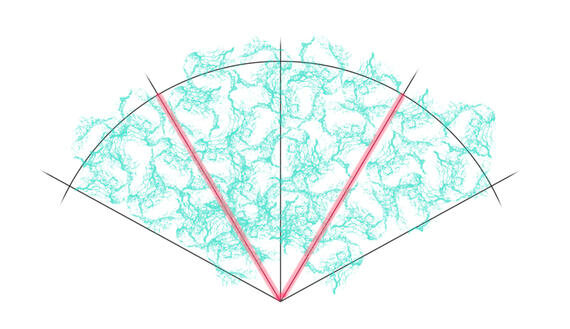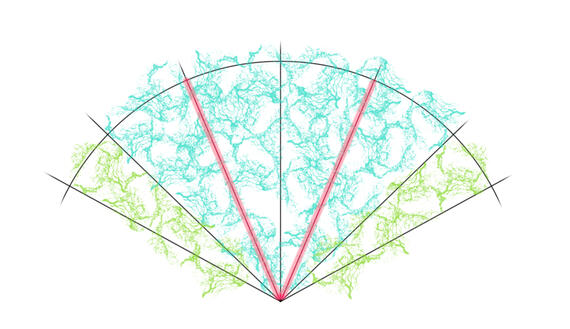The FBS-2 Stereo Technique
Wide angle stereo technique for atmos and soundscapes in field recording
by Fabian H.
FBS and FBS-2 are equivalence stereo techniques, that allow you to capture the full width of natural soundscapes while preserving a lively and realistic sound image. Setup and characteristics:
This article covers the theory behind FBS-2. FBS is a complementary technique covered in a dedicated article. Feel free to skip the theory and try them yourself. Both can be achieved using a standard 20cm stereo bar.
Let's optimize
FBS is well suited to capture rich and realistic sounding atmos. There are situations though where you might want to have a lower mid-side inhomogeneity. This is the aim of FBS-2. So, if we want to reduce mid-side inhomogeneity, we should first find a way to quantize it.As mentioned in the FBS article mid-side inhomogeneity is a direct consequence of the mic axis angle in relation to the SRA. With a too narrow or too wide mic axis angle in relation to the SRA a significant part of the sounds within the SRA will hit the mic capsules where there is noticeable off-axis-coloration. Put in mathematical terms the relation between mic axis angle looks like this:
i = SRA / mic axis angle
Let's call this mid-side inhomogeneity index i. It tells how often the mic axis angle fits into the SRA. i = 4 means that the mic axis angle fits into the SRA 4 times. i = 1 means both are identical. Lower values indicate that the mic axis angle is wider than the SRA.
Another way to look at it is to assume a focus field (blue) that is twice the size of the mic axis angle. In mathematical terms:
f = ( 2 * mic axis angle ) / SRA
This is the focus field index f. It's more or less the same as i. Mathematically it's just the reciprocal value of i multiplied by 2. Anyway, I'm using both indeces in parallel, because both are suited to display attributes respectively.
Thinking about it, f = 1.0 seems ideal, as the focus field covers the whole SRA that way. Lower values indicate that the focus field is more narrow than the SRA. That's the case for FBS, with f = 0.5, i.e. half of that SRA is covered by the focus field. That's what we want to optimize here. From f = 0.5 we're trying to get as close to f = 1.0 as possible, without losing too many favourable characteristics.But first, let's have a look at 'what the others got' in terms of focus field:
| Name | Spacing | Angle | ∆L / ∆t | SRA (exact) | i | f |
|---|---|---|---|---|---|---|
| ORTF | 17cm | 110° | 60.5 / 39.4 | 96.36° | 0.88 | 2.28 |
| RAI | 21cm | 100° | 53.4 / 46.5 | 92.81° | 0.93 | 2.15 |
| DIN | 20cm | 90° | 52.6 / 47.3 | 101.5° | 1.13 | 1.77 |
| EBS | 25cm | 90° | 46.8 / 53.1 | 90.06° | 1.00 | 2.00 |
| NOS | 30cm | 90° | 42.3 / 57.6 | 81.01° | 0.90 | 2.22 |
| FBS | 20cm | 40° | 41.6 / 58.3 | 161.3° | 4.03 | 0.50 |
Most established techniques crowd around f = 2.0. Values higher than 1.0 indicate that the focus field is wider than the SRA. The wider the focus field (above SRA), the higher the overall coloration. So, did they miss something? Why is it that way? Because stereo technique is all about compromise. A SRA of 90° (roughly representing ORTF, DIN, EBS, NOS, RAI) could be achieved with a mic angle of 45° and 40cm mic spacing, giving f = 1.0 (perfect!!) and a ∆L/∆t of 24.0/75.9 (oh...). Direct result of aiming for a SRA of 80-100° (optimal for music on stage) and a ∆t of 40-60% (seems to hit most peoples personal taste and secures even stereo distribution).
So, let's get systematic and find a compromise of getting as close to f = 1.0 as possible while still remaining a ∆t above - say - 45%, and an appropriately wide SRA.
Setups with
i = 2.0 (Twice the mic axis angle is SRA.)
f = 1.0 (Focus field is identical to SRA.)

| Spacing | Angle | ∆L / ∆t | SRA (exact) | Note |
|---|---|---|---|---|
| 22cm | 60° | 43.1 / 56.8 | 120° (121.0°) | SRA too narrow |
| 18cm | 65° | 50.3 / 49.6 | 130° (130.4°) | SRA too narrow |
| 14cm | 70° | 58.9 / 41.0 | 140° (142°) | SRA too narrow |
| 11cm | 75° | 66.5 / 33.4 | 150° (150.6°) | ∆t too low |
| 8cm | 80° | 75.0 / 24.9 | 160° (160.4°) | ∆t too low |
| 5cm | 85° | 84.1 / 15.8 | 170° (171.5°) | ∆t too low |
No pleasing results here. So, let's increase i a little bit.
Setups with
i = 2.5 (2.5 times the mic axis angle is SRA)
f = 0.8 (Focus field covers 4/5 of the SRA)

| Spacing | Angle | ∆L / ∆t | SRA (exact) | Note |
|---|---|---|---|---|
| 15cm | 60° | 55.2 / 44.7 | 150° (151.3°) | - |
| 8cm | 70° | 74.6 / 25.3 | 175° (176.1°) | ∆t too low |
15cm-60° is a candidate. Let's try to increase i further.
Setups with
i = 3 (3 times the mic axis angle is SRA)
f = 0,67 (Focus field covers 2/3 of the SRA)

| Spacing | Angle | ∆L / ∆t | SRA (exact) | Note |
|---|---|---|---|---|
| 29cm | 40° | 29.5 / 70.3 | 120° (121.3°) | SRA too narrow |
| 23cm | 45° | 37.8 / 62.1 | 135° (136.7°) | SRA too narrow |
| 18cm | 50° | 47.3 / 52.6 | 150° (152.2°) | - |
| 14cm | 55° | 52.3 / 47.6 | 165° (165.9°) | - |
| 11cm | 60° | 65.5 / 34.4 | 175° (175°) | ∆t too low |
| 10cm | 60° | 67.7 / 31.5 | 180° (181.6°) | ∆t too low |
18cm-50° and 14cm-55° are candidates.So, we have three candidates:
| Spacing | Angle | ∆L / ∆t | SRA (exact) | i | f |
|---|---|---|---|---|---|
| 15cm | 60° | 55.2 / 44.7 | 150° (151.3°) | 2.52 | 0.79 |
| 18cm | 50° | 47.3 / 52.6 | 150° (152.2°) | 3.04 | 0.66 |
| 14cm | 55° | 52.3 / 47.6 | 165° (165.9°) | 3.02 | 0.66 |
A SRA of 150° is borderline, which makes 14cm-55° with its 165° attractive. Looking at ∆L/∆t, 18cm-50° and 14cm-55° are ideal, but 15cm-60° is fine too in that respect. In terms of focus field 15cm-60° is the clear winner.Bringing together theoretical arguments, practical tests and personal taste, 15cm-60° is the ideal complement to FBS and is crowned as FBS-2.So, that's it, the soundscape dream team:
| Name | Spacing | Angle | ∆L / ∆t | SRA (exact) | i | f |
|---|---|---|---|---|---|---|
| FBS | 20cm | 40° | 41.6 / 58.3 | 160° (161.3°) | 4.03 | 0.50 |
| FBS-2 | 15cm | 60° | 55.2 / 44.7 | 150° (151.3°) | 2.52 | 0.79 |
Thanks again. I'll be delighted to hear from you.